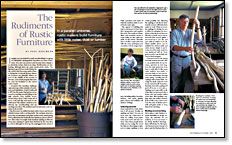The Rudiments of Rustic Furniture
In a parallel universe, rustic makers build furniture with little noise, dust or lumber
Synopsis: Paul Ruhlmann helped a group of ninth-graders transform brush-pile sticks into handsome pieces of furniture. In this article he details how to make rustic-style furniture with just a few tools and found materials. After providing tips for collecting and preparing greenwood branches, Ruhlmann covers the basics of construction and final finishing. One of the biggest challenges is drilling the round mortises in the same plane, as the parts are often irregularly shaped. Follow Ruhlmann as he cutts the tenons with a special drill accessory he designed, assembles the front and rear panels of the chair, and finishes it off with armrests and a woven seat.
Imagine you are invited to teach woodworking to a group of enthusiastic ninth-graders—but there are some restrictions. You can’t use power tools because there simply is no electricity. In fact, there is no shop. Workbenches are also lacking, although there are some sturdy picnic tables. The lighting is good if you work during the day, and it’s dry if you stay under a leanto during the occasional shower. Materials, however, are plentiful. Where are you? In the middle of the woods on Bivouac, a two-week program that starts the year for freshmen at the school where I teach.
I accepted this teaching challenge eight years ago with a mixture of excitement and trepidation. Could I really pull it off? Over the years I had grown accustomed to teaching woodworking in the high school’s cozy, well-lit, woodframed shop. How could I leave all of those tools and jigs and teach in the wilderness? The answer I arrived at has affected my woodworking and my teaching ever since: The students and I would make rustic furniture in the woods!
That first year, we drilled mortises with a brace and bit and whittled tenons with a carving knife. The students showed a great deal of enthusiasm and pride in their work, transforming sticks pulled from the brush pile into handsome pieces of furniture. Since then I’ve taught rustic furniture making on Bivouac every year, enjoying it a great deal. And back in the cozy shop at school, although we don’t go the unplugged route, much of what I produce and some of what the students make is rooted in the rustic style.
The appeal of building this way is enormous: it is fast, intuitive, inexpensive and requires few tools. The results are immediate, and creativity seems to come easily. It is also quite versatile: In this article I describe how to build a rustic chair, but with the same techniques you can make a whole range of projects, including tables, benches, mirrors, coat racks, garden gates, fences and trellises—all manner of things.
Gathering materials
Great material for rustic furniture is all around. Freshly cut saplings are ideal. You can cut your own, but I find most of mine by calling local parks, town road crews and tree services. Once these people know what you are using the wood for, they are often happy to give you as many saplings as you could possibly use.
From Fine Woodworking #138
For the full article, download the PDF below:
Fine Woodworking Recommended Products

Veritas Micro-Adjust Wheel Marking Gauge

Stanley Powerlock 16-ft. tape measure

Drafting Tools






















Log in or create an account to post a comment.
Sign up Log in